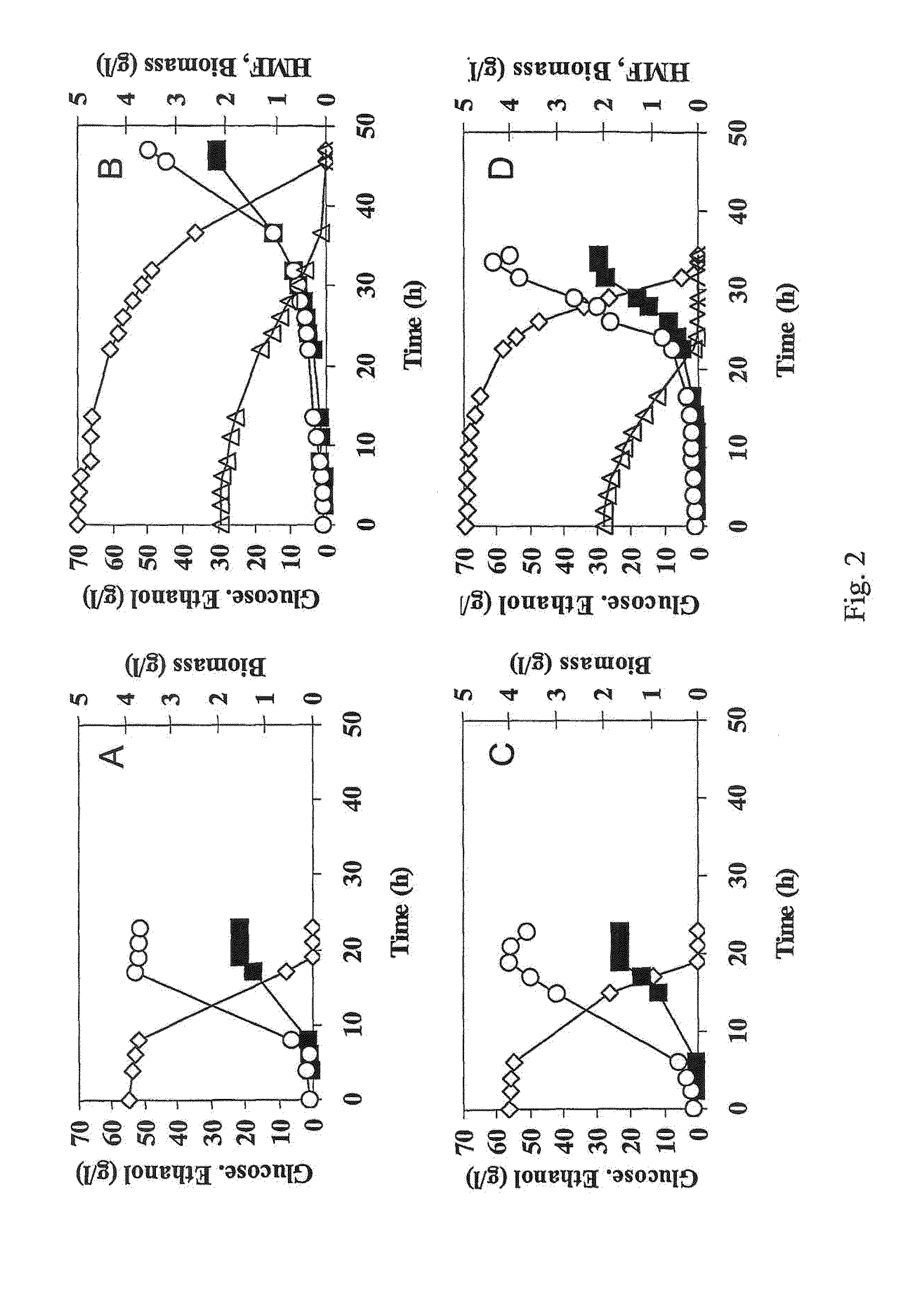Polypeptide having hadh dependent hmf reductase activity
- Summary
- Abstract
- Description
- Claims
- Application Information
AI Technical Summary
Benefits of technology
Problems solved by technology
Method used
Image
Examples
example 1
Identification of NADH-Dependent HMF Reductase
Purification of NADH-Dependent HMF Reductase
[0054]The industrial strain TMB3000 (ATCC96581) (Lindén et al., 1992, Isolation and characterization of acetic acid-tolerant galactose-fermenting strains of Saccharomyces cerevisiae from a spent sulfite liquor fermentation plant. Applied Environmental Microbiology 58(5):1661-1669) was grown in rich medium containing 10 g / l yeast extract, 20 g / l peptone and 20 g / l glucose supplemented with 10% spruce hydrolysate (Nilvebrant et al., 2003, Limits for alkaline detoxification of dilute-acid lignocellulose hydrolysates. Applied Biochemistry Biotechnology. 105-108:615-628) adjusted to pH 5.5. The hydrolysate was centrifuged for 10 minutes at 5000 g and supernatant was injected through 2μ filter (Sarstedt, Nümbrecht, Germany) before addition to the autoclaved medium. Growth took place in 1 L shake flasks (non-baffled), containing 250mL medium at 200 rpm and 30° C. Inoculation from a 5 ml over-night pre...
example 2
In Vivo HMF Uptake with Strain Expressing NADH-Dependent Reductase
[0063]Overexpression in S. cerevisiae CEN.PK 113-5D
[0064]Plasmid YEplac-HXT-ADH1-mut encoding the mutated ADH1 gene (as described in example 1), as well as the corresponding empty plasmid YEplacHXT (Karhumaa et al., 2005, Investigation of limiting metabolic steps in the utilization of xylose by recombinant Saccharomyces cerevisiae using metabolic engineering. Yeast. 22(5):359-368) were used to transform S. cerevisiae CEN.PK 113-5D (SUC2, MAL2-8c, MEL, ura3), resulting in strains TMB3206 and TMB3280, respectively. As expected, NADH-dependent HMF reductase activity was only detected in the strain carrying the mutated ADH1 gene (data not shown).
Aerobic In Vivo HMF Reduction
[0065]Strains TMB3206 and TMB3280 were pre-grown overnight in 5 ml defined medium (Verduyn et al., 1992. Effect of benzoic acid on metabolic fluxes in yeasts: a continuous-culture study on the regulation of respiration and alcoholic fermentation. Yeast...
example 3
Site-Directed Mutagenesis on NADH-Dependent HMF Reductase
[0071]Plasmid YEplacHXT-ADH1-mut encoding the mutated ADH1 gene from TMB3000 (as described in example 1) as well as plasmid YEPlac-HXT encoding the native ADH1 gene from CEN.PK 113-5D (named YEplacHXT-ADH1-nat) were used for site directed mutagenesis in order to investigate the influence of various amino acid mutation on NADH-dependent furan reductase activity.
[0072]Site-directed mutagenesis was performed according to the following protocol: A two-step PCR was used for the generation of an ADH1 gene with the chosen amino-acid changes. Six primers were designed for reverse mutagenesis of the mutated ADH1 gene at position 110 (P110S), 117 (S117L) and 295 (C295Y) and four other primers were designed for the mutagenesis of the native ADH1 gene at position 110 (S110P) and 295 (Y295C) (Table 3). Two primers for the amplification of ADH1 gene (mutated or not) were also created: primer ADH1 sense (5′-GGGGGGATCCATGTCTATCCCAGAAACTC-3′),...
PUM
| Property | Measurement | Unit |
|---|---|---|
| Fraction | aaaaa | aaaaa |
| Fraction | aaaaa | aaaaa |
| Fraction | aaaaa | aaaaa |
Abstract
Description
Claims
Application Information
 Login to View More
Login to View More - R&D
- Intellectual Property
- Life Sciences
- Materials
- Tech Scout
- Unparalleled Data Quality
- Higher Quality Content
- 60% Fewer Hallucinations
Browse by: Latest US Patents, China's latest patents, Technical Efficacy Thesaurus, Application Domain, Technology Topic, Popular Technical Reports.
© 2025 PatSnap. All rights reserved.Legal|Privacy policy|Modern Slavery Act Transparency Statement|Sitemap|About US| Contact US: help@patsnap.com



